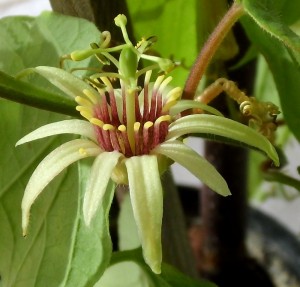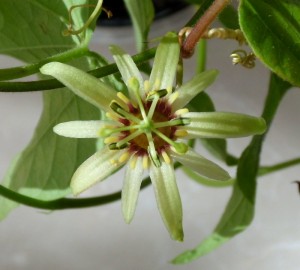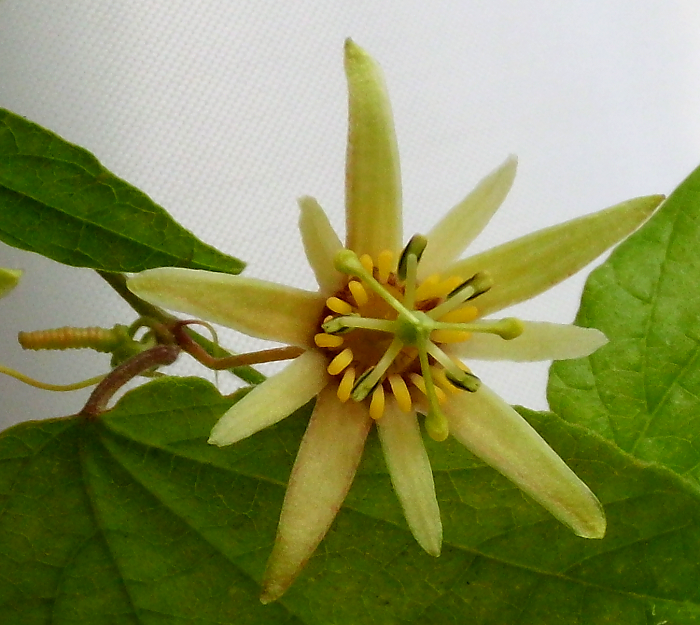Diese Passiflora decaloba Hybride könnte Passiflora ‚Komplex‘ heißen. Die Formel ist so kompliziert, dass ich sie mit einem Programmier-Tool editieren musste, um die Klammersetzung korrekt setzen zu können. Die Kreuzungsfomel lautet:
((citrina x sanguinolenta) x (((citrina x sanguinolenta) x citrina) x conzattiana)) x conzattiana
Und so sieht die Passiflora decaloba Hybride mit komplexer Kreuzungsformel aus – recht  unscheinbar für solch komplizierte Familienverhältnisse, finde ich. Vielleicht ein bisschen überzüchtet? Verlieren nicht überzüchtete Lebewesen ihre wertvollsten Eigenschaften? Nun, mir gefällt sie trotzdem. Gerade wegen ihrer vornehmen Blässe.
unscheinbar für solch komplizierte Familienverhältnisse, finde ich. Vielleicht ein bisschen überzüchtet? Verlieren nicht überzüchtete Lebewesen ihre wertvollsten Eigenschaften? Nun, mir gefällt sie trotzdem. Gerade wegen ihrer vornehmen Blässe.
Passiflora komplex: Entstehungsgeschichte dieser decaloba-Hybride
Die Entstehung der Elternpflanzen liegt schon einige Jahre zurück. Passiflora ‚Conny‘, der Elternteil aus dem ersten Term der Kreuzungsformel (citrina x sanguinolenta) ist im Jahr 2007 entstanden als Züchtung einer befreundeten Passiflora-Enthusiastin mit selbem Namen.
Die Passionsblume, die den mittleren Term der Kreuzungsformel bildet, Passiflora ‚Conny‘ x citrina, aufgelöst ((citrina x sanguinolenta) x citrina) x conzattiana), ist 2008 entstanden. Erst 2009 kam ich in den Besitz einer Passiflora conzattiana, mit der ich so ziemlich alles bestäubte, was mir halbwegs kompatibel erschien. Während dieser Zeit entstand auch die komplexe Kreuzung, welche die hier abgebildete Passiflora hervorgebracht hat. Ausgesät habe ich die Samen aber erst dieses Jahr, also 2012. Die kleine Pflanze hat sich schnell und gut entwickelt und hat bereits zahlreiche weitere Knospen gebildet!
Die Passiflora decaloba Hybride mit der komplexen Kreuzungsformel sieht ein wenig künstlich aus!
Ihre eigentümlich blassen Pastelltöne und die wachsartig glänzenden Bllütenblätter verleihen dieser Passiflora decaloba mit der komplexen Kreuzungsformel ein etwas künstliches Aussehen. Dieses Phänomen ist mir schon bei einigen anderen Passifloren aufgefallen. Erst wenn man diese Pflanzen berührt, merkt man, dass es sich keineswegs um Kunstblumen handelt.
Die Passiflora decaloba mit der komplexen Kreuzungsformel hat viel von der Passiflora conzattiana geerbt, insbesondere die Farbgebung. Die sehr hellgelben, fast weißen Blütenblätter sowie der lilafarbene Strahlenkranz mit den gelben Spitzen ähnelt der genannten Passionsblume stark. Was auf den Fotos hier nicht zu sehen ist, sind die Außenseiten der Blütenblätter. Jedes zweite Blatt ist rötlich gefärbt, wohl das einzige erkennbare Zeichen der Beteiligung von Passiflora sanguinolenta an dieser Kreuzung.
Der Durchmesser der Blüte beträgt 2 cm und ist somit wesentlich kleiner als der von Passiflora citrina. Von der citrina hat die Passi mit der komplexen Kreuzungsformel dagegen ihre schlanken Blütenblätter geerbt sowie die längliche Wuchsform der Blüte selbst. Die Blütenform der P. citrina erinnert mich immer an eine kleine Krone, weil sie sich die Blüte nur oben öffnet, nicht bis zum Ansatz.
Weitere Passiflora Porträts findest du hier auf MyPassiflora.de!
This Passiflora decaloba hybrid could be named Passiflora ‚Complex‘. The crossing formula is so complicated that I had to edit it with a programming tool, in order to get the brackets set correctly. The crossing formula is:
((citrina x sanguinolenta) x (((citrina x sanguinolenta) x citrina) x conzattiana)) x conzattiana
And this is how the Passiflora decaloba hybrid with complex crossing formula looks like – quite unimpressive for such a complicated family history, as I think. Maybe a little overbred? Didn’t I read recently that overbred creatures lose their best attributes? Anyway, I still like this flower. Especially for its noble paleness.
Passiflora complex: Evolutionary history of this decaloba hybrid
The evolution of the parent plants dates back several years. Passiflora ‚Conny‘, the parent which makes up the first term of the crossing formula (citrina x sanguinolenta) has been created in the year 2007, bred by a Passiflora enthusiast friend of mine having the same name.
The Passion Flower making up the middle term of the crossing formula, Passiflora ‚Conny‘ x citrina, dissolved ((citrina x sanguinolenta) x citrina) x conzattiana), has been created in 2008. Only in 2009, I acquired a Passiflora conzattiana. With this plant, I pollinated almost everything that seemed to be half-way compatible. During that time, also the complex crossing came into existence, whicht brought up the Passiflora you see here. I disseminated the seeds only this year, 2012. The small plant has grown quickly and well and already set more buds in the meantime!
The Passiflora decaloba hybrid with the complex crossing formula looks a little artificial!
Its strange pale pastel shades and the waxy glossy petals give quite an artificial look to this Passiflora decaloba with the complex crossing formula. This phenomenon attracted my attention with other Passiflora speices. Only when you touch these plants, you feel that they are by no means artificial plants.
Passiflora decaloba with the complex crossing formula has inherited much of Passiflora conzattiana, especially the colouring. The light yellow, almoust white petals and the purple corona with the yellow tops resemble the mentioned Passiflora. What you cannot see on the pictures here, are the outer faces of the petals. Every second petal is coloured reddish, probably the only recocnizable attribute inherited from Passiflora sanguinolenta in this crossing.
The diameter of the flower is 2 cm, much smaller than that of Passiflora citrina. From Passiflora citrina, the Passi with the complex crossing formula has inherited its slim petals, as well as the oblong habit of the flower itself. The flower habit of P. citrina reminds me of a small corona, because the flower doesn’t open fully down to the offspring, but only on its top.
More Passiflora Porträts you find here on MyPassiflora.de!
